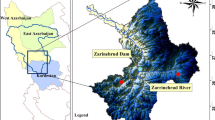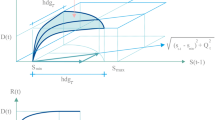Abstract
The discrete hedging rule which runs through several hedging phases can be an effective method for water supply operation from a reservoir during drought periods. This paper aims to derive two different hedging rule curves of a reservoir: one rule is based on available water that accompanies prediction of the current period inflow and the other rule is based on the beginning storage alone. The current period inflow was obtained by the ensemble streamflow prediction using historical precipitation data. A mixed integer programming algorithm was used to determine hedging rule curves for water supply operation of Hapcheon dam, the Republic of Korea for the period from 1990 to 2005 that included a drought period. Complying with the derived hedging rules, reservoir simulation runs for the period from 2006 to 2010 were performed. The derived hedging rule curves based on the beginning storage were placed higher than the curves based on available water and induced earlier rationing of water supply. The rule based on available water included the current period inflow and its simulation resulted in faster recovery to the normal phase of water supply when the drought ended. The simulation results applying the rule based on available water were 25% better in terms of the total water supply deficit and reliability; they, however, were 5% worse on the vulnerability. When predicted inflow is not reliable, the hedging rule based on the beginning storage might be worth in practical reservoir operation to avoid severer shortage resulted from the bad prediction of the inflow.








Similar content being viewed by others
References
Adeloye AJ, Soundharajan BS, Ojha CSP, Remesan R (2016) Effect of hedging-integrated rule curves on the performance of the pong reservoir (India) during scenario-neutral climate change perturbations. Water Resour Manag 30(2):445–470
Croley TE (2003) Weighted-climated parametic hydrologic forecasting. J Hydrol Eng 6(4):171–180
Duan Q (1991) A global optimization strategy for efficient and effective calibration of hydrologic models. Ph.D. dissertation, University of Arizona, Tucson, Arizona
Jeong D, Kim Y, Cho S, Shin H (2003) A study of rainfall-runoff models for improving ensemble streamflow prediction, rainfall-runoff models using artificial neural networks. KSCE J Civil Eng 23(6B):521–530
** Y, Jung T, Lee S, Kang S (2016) Reservoir operations of Hapcheon dam applying a discrete hedging rule and ensemble streamflow prediction to cope with droughts. J Korean Soc Hazard Mitig 16(1):93–101
Hashimoto T, Stedinger J, Loucks D (1982) Reliability, resiliency, and vulnerability criteria for water resources system evaluation. Water Resour Res 18:14–20
Kang S, Lee S, Kang T (2017) Development and application of storage-zone decision method for long-term reservoir operation using the dynamically dimensioned search algorithm. Water Resour Manag 31(1):219–232
Lee S, ** Y, Park J (2017) Comparison of hedging rule curves depending on available water and current storage in reservoir operation under droughts. Eur Water 60:227–232
Ministry of Land, Infrastructure and Transport (2015) Standard of water supply regulation to cope with water shortage. Ministry of Land, Infrastructure and Transport
Mohammad RN, Hamid M, Tomas CP (2012) Ensemble streamflow prediction: climate signal weighting methods vs. climate forecast system reanalysis. J Hydrol 442-443:105–116
Najafi MR, Moradkhani H (2016) Ensemble combination of seasonal streamflow forecasts. J Hydrol Eng, 21(1): 04015043–1–13
Neelakantan TR, Pundarikanthan NV (1999) Hedging rule optimization for water supply reservoirs system. Water Resour Manag 13(6):409–426
Shiau JT, Lee HC (2005) Derivation of optimal hedging rules for water-supply reservoir through compromise programming. Water Resour Manag 19(2):111–132
Shih JS, Revelle CS (1995) Water supply operations during drought: a discrete hedging rule. J Water Resour Plan Manag, ASCE 82:163–175
Stedinger JR, Kim Y (2010) Probabilities for ensemble forecast reflecting climate information. J Hydrol Eng 391(1):9–23
Sugawara M, Watanabe, I, Ozaki E, Katsuyama Y (1984) Tank model with snow component. National Research Center for disaster prevention, no. 65, Japan
Taghian M, Rosbjerg D, Haghighi A, Madsen H (2014) Optimization of conventional rule curves coupled with hedging rules for reservoir operation. J Water Resour Plan Manag 140:693–698
Tatano H, Okada N, Kawai H (1992) Optimal operation model of a single reservoir with drought duration explicitly concerned. Stochastic Hydrol Hydraul 6:123–134
U.S. Army Corps of Engineers (1996) Develo** seasonal and long-term reservoir system operation plans using HEC-PRM, Resources Development. Vol. 7. Hydrologic Engineering Center, Davis, CA
Wan W, Zhoa J, Lund JR, Zhoa T, Lei X, Wang H (2016) Optimal hedging rule for reservoir refill. J Water Resour Plan Manag 142(11):04016051–1–04016051–0401605111
You JY, Cai X (2008a) Hedging rule for reservoir operations: 1. a theoretical analysis. Water Resour Res 44(1):W01415–1–W01415–9
You JY, Cai X (2008b) Hedging rule for reservoir operations: 2. a numerical model. Water Resour Res 44(1):W01416–1–W0141611
Acknowledgements
This work is partly supported by the Korea Environmental Industry & Technology Institute (KEITI) grant funded by the Ministry of Environment (Grant 18AWMP-B083066-05). This work is also supported by a grant (NRF-2017R1A2B2003715) from the National Research Foundation of Korea (NRF), funded by the Ministry of Education of the Korean government.
Author information
Authors and Affiliations
Corresponding author
Ethics declarations
Conflict of Interest
None.
Additional information
Publisher’s Note
Springer Nature remains neutral with regard to jurisdictional claims in published maps and institutional affiliations.
Rights and permissions
About this article
Cite this article
**, Y., Lee, S. Comparative Effectiveness of Reservoir Operation Applying Hedging Rules Based on Available Water and Beginning Storage to Cope with Droughts. Water Resour Manage 33, 1897–1911 (2019). https://doi.org/10.1007/s11269-019-02220-z
Received:
Accepted:
Published:
Issue Date:
DOI: https://doi.org/10.1007/s11269-019-02220-z




